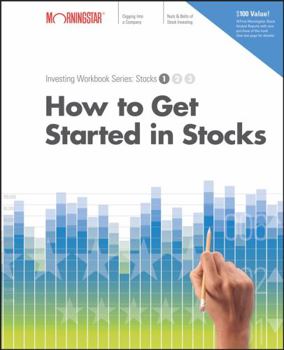How to Get Started in Stocks
Select Format
Select Condition 
Book Overview
3 Easy Steps to Better Stock Investing Lessons explain key stock investing concepts clearly and simply to help you learn quickly. Quizzes reinforce and build on what you learn. Worksheets let you put... This description may be from another edition of this product.
Format:Paperback
Language:English
ISBN:0471719579
ISBN13:9780471719571
Release Date:August 2005
Publisher:Wiley
Length:384 Pages
Weight:0.95 lbs.
Dimensions:0.5" x 7.5" x 9.2"
Customer Reviews
3 ratings
Good introduction to stocks by a great company
Published by Thriftbooks.com User , 14 years ago
Anything written by Morningstar provides high quality investment advice. This book provides a basic introduction to stocks. It provides an overview on how stocks compare to other investment products, how compounding works, and why it is important to invest long term. Since stocks are ways to become owners in the underlying businesses, the author explains how to analyze individual companies first by gathering relevant information, reading financial statements, and performing basic ratio analysis. At the end of each chapter, there is a quiz and worksheet. Since the book is written by Morningstar, it provides information on how to use the company's website. Morningstar offers subscription services to individual investors who can get access to analyst reports and opinions of value on individual companies. Besides reading this book, I recommend their subscription. - Mariusz Skonieczny, author of Why Are We So Clueless about the Stock Market? Learn how to invest your money, how to pick stocks, and how to make money in the stock market
Even if you know nothing, this is a great book to start with.
Published by Thriftbooks.com User , 16 years ago
I have come to trust Morningstar quite a lot for my financial education. I truly believe that they are trying to do good things for the world by making this kind of material available. I am not a novice investor, but I decided to buy the entire stock workbook series, and go through them all from start to finish. I found that for an intermediate investor, there was a lot of information that I already knew in the early chapters of this book, but I still learned a lot. Even with the information that I was already familiar with, it was new to me to take a quiz over that information. This was really helpful in making this material even more intimate to me. I finally learned how to really get started with financial documents in regards to evaluating potential investments too. I think the workbook approach was the right idea. I might be years out of school, but I love to learn and be challenged, so I jumped at the chance to break out a #2 pencil and take a quiz. Call me a dork, but this book helped with giving me some more confidence that I can better pick out good companies that would potentially be good investments. The writing is very economical and entertaining. I had a good time reading through this book. Not nearly as dull as I was expecting, in fact, not dull at all. Whoever said that accountants and financial/banking types don't have a sense of humor has never read anything Paul Larson has written. I can't wait to learn more and get started with workbook #2.
Great Way to Get Started
Published by Thriftbooks.com User , 17 years ago
Whether you know a little about stocks and need to know more, or you're totally clueless and want to learn it all, the beginning of this 3-part series is absolutely indispensible for you. It starts out very basic (mentioning what stocks are, for instance) and demonstrates the miracle of compound growth and interest over time, and why it is important to invest in stocks in the first place, rather than just savings bonds, CDs or a so-called "safe" investment, which isn't really safe since you won't make near enough money to beat inflation (you'll be losing money unless you invest in stocks). But then it goes on to demonstrate some very useful things to someone who wants to investigate a stock in order to decide to buy it or not, like, how to read the company's "big three" (balance sheet, cash flow statement, earnings statement) in its annual report and what it all means and, how to calculate some very basic ratios and "dig into the company." Believe it or not, simple stuff, and presented in a simple, and practical manner that anyone can understand. You don't need to be a math wiz in order to read this book, or have any financial education or experience at all. But it's a great place to get started, and this book is totally necessary if you want to understand stocks and the companies behind them. I highly recommend How to Get Started in Stocks, and the 3-part series in general.




